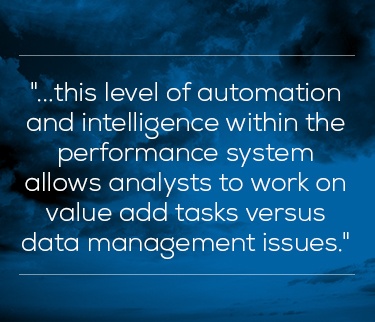 Flexibility and advanced functionality are the watchwords of any modern middle office when it comes to performance measurement.
Flexibility and advanced functionality are the watchwords of any modern middle office when it comes to performance measurement.
Without the flexibility to increase workload, the middle office cannot service an ever expanding set of stakeholders.
And without best of breed functionality that digs down through processes and workflows to the underlying data, any service becomes bogged down by inefficiency and time lapses which can delay the whole operation, especially at month end.
Flexibility
For flexibility we can also read scalability. Whichever term you use, the point is to be able to reduce turnaround time for delivering performance results.
Today, instant access to parallel cloud-based processing – such as Amazon Web Services – has revolutionized the extent to which portfolio analytics platforms can handle exceptionally huge data volumes. With this infrastructure in place, asset managers are now able to deal with peak processing demands that would have previously inundated the system, without any worry. It means there is no need to switch data from one system to another or create a workload queue due to having a system with insufficient capacity.
In turn, this level of instant scalability makes data management and issue resolution more timely. And time is, after all, money.
{{cta(‘bcdd0f82-15ab-4a31-97d7-953aaeb085d7’)}}
Scalability and speed combined also reduces manual overheads for performance teams. Ideally teams should be working with a high degree of automation, an advanced workflow and state of the art data management capabilities.
Advanced functionality
Knowing that scalability and speed capability is woven into the system means that the middle office can programme-in advanced functionality with the confidence that the system can handle what is asked of it – no matter how big or how complex – in good time. In other words, the end result is a superior analytical result that is delivered on schedule, no matter what other demands are already placed on the system.
Good systems that are using the cloud also make for improved data sharing. This means that performance and analytical results – honed to perfection as a result of advanced functionality – are immediately accessible across the entire firm.
Configurability
But reaching a high quality of analytical capability relies on being able to easily configure the system to suit that individual manager’s operational processes and structures. Data and results control checks should be automated and instantly visible. This highly automated and advanced workflow process, including dependency management, relies on enabling fast, efficient set-up, automation and monitoring even for the very largest asset management firms.
Beneath the configuration comes the issue of accuracy. No system will perform well unless accurate and consist calculations are prioritized. The team needs to be able to access and adjust methodologies and a good system should include highly flexible TW and MW return methodologies, including:
- Multiple methodologies supported per Portfolio and Share Class
- Highly configurable transaction timing for TWR calculations
- User definable return types allowing gross-up/net-down for any fee types
Data must be automated and in the case of returns being flagged as not quite right or even abnormal, the system needs to be intelligent and flexible enough to firstly flag the issue and then resolve the issue via an exceptions-based process. This can help eliminate abnormal returns that can be difficult to explain to fund managers and clients. Having this level of automation and intelligence within the performance system allows analysts to work on value add tasks versus data management issues.
The system then needs to provide an audit trail for all changes and all its performance data, including having an independent, four eyes validation and sign-off process, when required. Having this as part of the workflow process helps bring everything together, from initial data imports through to validation and sign-off for further analysis such as attribution and risk.
All of this combined massively reduces the operational risk and the needs for manual workarounds and manual processes outside of the system and thus promotes both accuracy and timeliness of performance results.
Future growth
A system that can expand horizontally to give bandwidth and reach down vertically to each aspect of performance management effectively removes any constraints on future business growth.
Having auto-scalability means that growth can be easily and instantly accommodated without having to worry about scaling up costs. It also largely removes operational and processing constraints.
Ease of use of advanced configuration also future proofs the business in that tweaks and changes can be easily incorporated. In addition, holding the system remotely in the cloud means that updates and new functionalities and features can be automatically deployed, without individual users having to do anything. Again this makes for operational efficiency and leaves users free to get on with their actual jobs.
Takeaways
- A system needs to be flexible enough to expand to meet the manager’s work volume
- It also needs to dig down vertically to provide advanced functionality to each and every aspect of performance measurement
- Configuration and automation is key to being able to make the most of a system
- The system needs to be user friendly with visualization to aid workflow and data management
{{cta(‘fa3b4f0d-4c30-4f05-8a1f-f9f2febb3edb’)}}